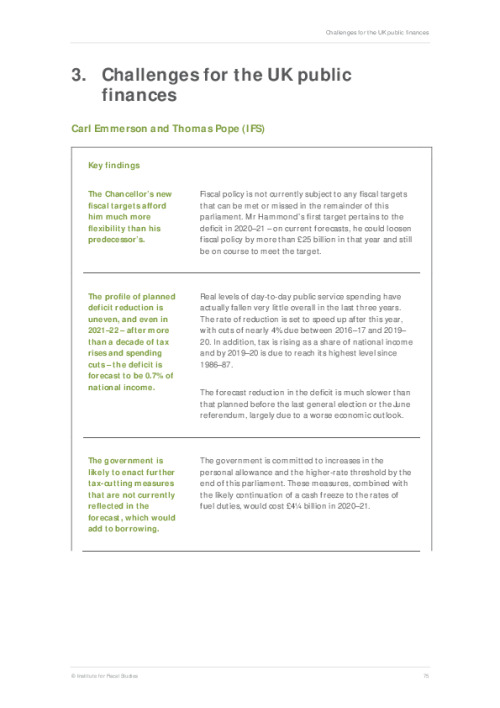This chapter is part of the IFS Green Budget 2017.
Despite having been enshrined in legislation as recently as October 2015, the government has abandoned its commitment to deliver an overall budget surplus in 2019–20. This occurred in the aftermath of June’s vote to leave the European Union (EU) and was subsequently followed by a downgrade in the official economic forecasts in November. The new Chancellor, Phillip Hammond, has said that the previous commitment will be replaced with a less specific pledge to deliver a budget surplus ‘as early as possible in the next Parliament’.
Even achieving this is likely to be difficult. The deficit this year is forecast by the Office for Budget Responsibility (OBR) to be £68.2 billion or 3.5% of national income. This is high by UK historical standards. Over the 60 years from 1948 until the eve of the financial crisis and associated recession, average UK government borrowing was 1.9% of national income. After six years of ‘austerity’, the deficit this year will still be higher than it was 80% of the time in the 60 years before the financial crisis, while debt is now at its highest level as a proportion of national income since 1965–66. And, as stated in Chapter 2, there is probably more uncertainty now over future prospects than at any point in the last 60 years.
This chapter looks in detail at the latest official forecasts for the public finances and discusses some of the key risks around them. Section 3.2 sets out the broad picture on the public finances, including the forecast for the deficit and debt over the next few years and the fiscal targets that the government has set itself. Section 3.3 looks in more detail at the planned fiscal consolidation, how it is to be achieved and how it compares with previous consolidation plans for this parliament. Section 3.4 explores the main risks around the medium-term forecast, while Section 3.5 concludes, with a focus on the challenge of eliminating the deficit in the next parliament. A postscript in Section 3.6 acknowledges the latest set of Bank of England forecasts, which were published on the same day as this document went to print.
Key findings
The Chancellor’s new fiscal targets afford him much more flexibility than his predecessor’s.
Fiscal policy is not currently subject to any fiscal targets that can be met or missed in the remainder of this parliament. Mr Hammond’s first target pertains to the deficit in 2020–21 – on current forecasts, he could loosen fiscal policy by more than £25 billion in that year and still be on course to meet the target.
The profile of planned deficit reduction is uneven, and even in 2021–22 – after more than a decade of tax rises and spending cuts – the deficit is forecast to be 0.7% of national income.
Real levels of day-to-day public service spending have actually fallen very little overall in the last three years. The rate of reduction is set to speed up after this year, with cuts of nearly 4% due between 2016–17 and 2019–20. In addition, tax is rising as a share of national income and by 2019–20 is due to reach its highest level since 1986–87.
The forecast reduction in the deficit is much slower than that planned before the last general election or the June referendum, largely due to a worse economic outlook.
The government is likely to enact further tax-cutting measures that are not currently reflected in the forecast, which would add to borrowing.
The government is committed to increases in the personal allowance and the higher-rate threshold by the end of this parliament. These measures, combined with the likely continuation of a cash freeze to the rates of fuel duties, would cost £4¼ billion in 2020–21.
Focusing public spending cuts on the day-to-day spending of (unprotected) government departments, while increasing capital spending, is changing the make-up of government spending.
In 2007–08, central government spending on public services comprised 17p of capital spending for every £1 of day-to-day spending. In 2012–13, this had fallen to 13p of capital spending for every £1 of day-to-day. The forecasts imply that in 2021–22 this will increase to 21p of capital spending for every £1 of day-to-day.
By the end of the parliament, public spending on health, pensions and overseas aid will be higher as a share of national income than in 2007–08, while spending on schools, defence and (in particular) public order & safety will be lower.
Uncertainty surrounding the economic forecast is the largest risk to the public finances.
The Office for Budget Responsibility (OBR) downgraded the size of the economy in 2020–21 by 1.2% between March and November, but other forecasters are more pessimistic. If growth is lower than expected, borrowing is likely to increase. The public finances will also deteriorate if the fall in sterling leads to a greater-than-expected increase in household inflation and/or interest rates turn out higher than forecast.
Past forecasting performance suggests there is a one-in-five chance that the deficit in 2021–22 will actually be around or above its current level of 3.5% of national income. More optimistically, there is almost a two-in-five chance that there will be an overall budget surplus in that year.
The main objective of fiscal policy – returning the public finances to balance as soon as possible in the next parliament – will be made harder by forecast sluggish growth and pressures on public spending.
Demographic and non-demographic pressures are projected to put upward pressure of 1.0% of national income on health, social care and pension spending by 2025. Taking into account possible negative effects from lower growth, the government may need to enact further measures worth £40 billion (in 2016–17 terms) in order to eliminate the deficit in the next parliament.










